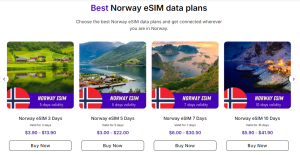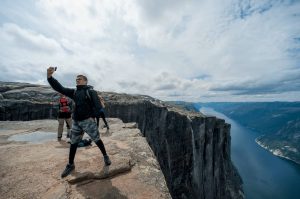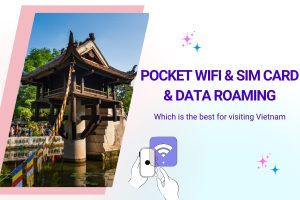The best time to visit Norway is during the summer months from June to August. This period is considered the high season as Norway experiences its warmest weather during this period without much rainfall.
Midsummer in June offers exceptionally long days, with the sun setting after 11pm in the north. In July, many places above the Arctic circle even experience continuous daylight. The summer season also experiences the lowest levels of rainfall. Oslo receives on average only 10 rainy days in June and July. This ensures stable weather conditions and a high likelihood of sunny skies during your trip.
It’s also the prime season for fresh, local produce. Forests are lush with berry picking in the summer months. Blueberries, raspberries, lingonberries and gooseberries can be foraged throughout June to September.
While summer is Norway’s busiest tourist period, the country’s abundant natural spaces mean crowds are never excessive. For those seeking slightly fewer visitors, the shoulder seasons of May, September and early June offer great scenic beauty from the autumn foliage with relatively comfortable weather still.
II. What to Pack for Norway
Packing for Norway requires careful consideration of the weather and activities you plan to engage in. The country’s climate can vary greatly depending on the region and season, so being prepared is essential.
Clothing Essentials
Regardless of the season, layering is key when packing for Norway. Start with moisture-wicking base layers to keep you dry, followed by insulating mid-layers like fleece or wool. Finally, invest in a waterproof and windproof outer layer to protect against the elements.
For summer visits, lightweight clothing is suitable, but don’t forget a light jacket for cooler evenings. In winter, heavy-duty thermal wear, insulated jackets, and waterproof boots are crucial for staying warm and comfortable.
Footwear
Comfortable footwear is essential for exploring Norway’s diverse terrain. For summer trips, a good pair of hiking shoes or sandals will serve you well. In winter, opt for insulated, waterproof boots with good traction to navigate snowy and icy conditions.
If you plan to explore cities, consider packing a pair of comfortable walking shoes for urban adventures. Flip-flops or slippers can also be handy for accommodations.
Accessories and Gear
Accessories play a significant role in ensuring a comfortable trip. A wide-brimmed hat and sunglasses are essential for summer, while gloves, scarves, and beanies are must-haves for winter.
Don’t forget a reusable water bottle to stay hydrated during your adventures. If you’re planning to hike, trekking poles can provide additional support on rugged trails. A portable charger for your devices is also a wise investment, especially if you plan to capture the stunning scenery.
Toiletries and Personal Items
While most toiletries can be found in Norway, it’s advisable to bring any specific products you prefer. Sunscreen is essential in summer, while lip balm and moisturizer are vital in winter to combat dry air.
A basic first-aid kit with essentials like band-aids, pain relievers, and any personal medications is also recommended. Lastly, ensure you have travel insurance that covers medical emergencies and unexpected events.
III. How Many Days Do I Need in Norway?
Determining how many days to spend in Norway depends on your interests, budget, and the regions you wish to explore. While a week might suffice for a quick overview, a longer trip allows for a deeper dive into the country’s beauty and culture.
Short Trips: 5 to 7 Days
If you have limited time, focusing on one or two regions is advisable. A popular itinerary includes spending a few days in Oslo, exploring the capital’s museums, parks, and vibrant neighborhoods. From there, you can take a scenic train ride to Bergen, known for its charming old town and access to the fjords.
Alternatively, consider a trip to the Lofoten Islands for stunning landscapes and outdoor activities. A week-long trip can provide a taste of Norway’s highlights, but be prepared for a fast-paced itinerary.
Moderate Trips: 10 to 14 Days
For a more immersive experience, consider extending your trip to 10 to 14 days. This timeframe allows you to explore multiple regions, such as the fjords, northern lights, and cultural hubs.
You could start in Oslo, then head to the fjords, visiting places like Geirangerfjord and Sognefjord. Afterward, make your way north to Tromsø for a chance to see the Northern Lights and experience Arctic activities. This moderate itinerary provides a balance of city exploration and natural wonders.
Extended Trips: 2 Weeks or More
If you have the luxury of time, a two-week or longer trip allows for a comprehensive exploration of Norway. You can delve into the country’s rich history, culture, and diverse landscapes.
Consider starting in Oslo, then traveling along the coast to explore the picturesque towns of Ålesund and Molde. Spend time in the fjords, hike iconic trails, and venture into the northern regions for a chance to see the midnight sun or Northern Lights. An extended trip enables you to connect with locals, savor traditional cuisine, and fully appreciate Norway’s breathtaking beauty.
IV. Best Things to Do Your First Time in Norway

Norway is brimming with incredible experiences, from stunning natural landscapes to vibrant cities. Here are some of the top activities to consider during your first visit.
Explore the Fjords
No trip to Norway is complete without experiencing its famous fjords. These deep, narrow inlets carved by glaciers offer breathtaking views and opportunities for adventure.
Popular fjords include Geirangerfjord, known for its dramatic waterfalls and steep cliffs, and Nærøyfjord, a UNESCO World Heritage site. Consider taking a fjord cruise or kayaking to truly immerse yourself in the stunning surroundings. Hiking trails along the fjords provide panoramic views and a chance to connect with nature.
Discover Oslo
As Norway’s capital, Oslo is a vibrant city that seamlessly blends modernity with history. Spend time exploring the city’s numerous museums, including the Viking Ship Museum, which showcases well-preserved Viking ships and artifacts.
Visit the iconic Oslo Opera House, where you can walk on the roof for stunning views of the city and fjord. Don’t miss Vigeland Park, home to over 200 sculptures by artist Gustav Vigeland, offering a unique glimpse into human emotions and relationships.
Experience the Northern Lights
For many travelers, witnessing the Northern Lights is a bucket-list experience. The best time to see this natural phenomenon is during the winter months in northern Norway.
Tromsø, often referred to as the “Gateway to the Arctic,” is one of the best places to view the Northern Lights. Join guided tours that take you away from city lights for optimal viewing conditions. Be sure to dress warmly and bring a camera to capture this breathtaking spectacle.
Visit the Lofoten Islands
The Lofoten Islands are renowned for their dramatic landscapes, picturesque fishing villages, and outdoor activities. Spend time hiking the islands’ rugged terrain, exploring hidden beaches, and enjoying fresh seafood at local restaurants.
The islands also offer opportunities for kayaking, fishing, and even surfing in the summer months. In winter, the Lofoten Islands provide a stunning backdrop for Northern Lights viewing, making them a year-round destination for adventure seekers.
V. Getting to Norway
Reaching Norway is relatively straightforward, with several international airports and transportation options available. Understanding the best ways to get to Norway will help streamline your travel plans.
Flying to Norway
Oslo Gardermoen Airport (OSL) is the main international gateway to Norway, with direct flights from major cities worldwide. Other airports, such as Bergen Airport (BGO), Stavanger Airport (SVG), and Tromsø Airport (TOS), also receive international flights, though they may have fewer connections.
When booking flights, consider flying into Oslo and then taking domestic flights or trains to other destinations within Norway. This approach maximizes your time and allows you to explore various regions.
Train Travel
Norway boasts an extensive and efficient rail network, making train travel a popular option for getting around the country. The scenic train rides, such as the Flåm Railway and the Bergen Line, offer breathtaking views of the landscape.
Consider purchasing a Norway Rail Pass for unlimited travel on the national rail network, which can save you money if you plan to visit multiple cities. Trains are comfortable and provide a relaxing way to soak in the scenery.
Ferries and Public Transport
Ferries are an integral part of Norway’s transportation system, particularly for reaching islands and coastal towns. Consider taking a ferry ride to experience the stunning fjords and islands firsthand.
Public transport, including buses and trams, is reliable in cities like Oslo and Bergen. Purchasing an Oslo Pass or Bergen Card can provide unlimited public transport access and discounts on attractions, making it easier to navigate the cities.
VI. Best Way to Get Around Norway

Once you’ve arrived in Norway, choosing the best mode of transportation to explore the country is essential. Each option has its advantages, depending on your preferences and itinerary.
Trains
Norway’s train system is efficient and scenic, making it a popular choice for travelers. Major routes connect cities like Oslo, Bergen, and Trondheim, with stunning views along the way. Consider taking the scenic Flåm Railway, which offers breathtaking views of fjords and mountains. Train travel is comfortable, and onboard amenities often include dining options and free Wi-Fi.
Buses
Buses are a cost-effective way to travel between cities and rural areas. Several bus companies operate routes throughout Norway, providing access to remote destinations not served by trains.
While bus travel may take longer than trains or flights, it offers the opportunity to see more of the countryside. Some scenic bus routes, such as the Atlantic Road, provide stunning views and photo opportunities.
Car Rentals
Renting a car gives you the freedom to explore Norway at your own pace. With well-maintained roads and breathtaking scenery, driving can be an enjoyable experience.
However, be prepared for tolls on certain roads and bridges. Parking can be challenging in cities, so research parking options in advance. Additionally, familiarize yourself with local driving laws and regulations, especially regarding wildlife crossings.
VII. Where is the Best Place to Stay in Norway?
Choosing the right accommodation is crucial for a comfortable and enjoyable stay in Norway. The options range from hotels and hostels to cabins and unique lodgings, catering to various budgets and preferences.
Hotels and Resorts
Major cities like Oslo, Bergen, and Tromsø offer a wide range of hotels, from luxury resorts to budget-friendly options. Look for hotels that provide amenities such as complimentary breakfast, Wi-Fi, and easy access to public transport.
In popular tourist areas, consider booking accommodations with fjord views or proximity to hiking trails. Many hotels also offer guided tours and activities, making it convenient to explore the surrounding area.
Hostels and Guesthouses
For budget-conscious travelers, hostels and guesthouses provide affordable lodging options. Many hostels offer dormitory-style rooms, while guesthouses may have private rooms with shared facilities.
Staying in hostels can also provide opportunities to meet fellow travelers and share experiences. Look for hostels that organize group activities or excursions to enhance your travel experience.
Cabins and Lodges
For a unique experience, consider renting a cabin or lodge in the countryside or near the fjords. Many cabins come equipped with kitchens, allowing you to cook your meals and enjoy the tranquility of nature.
Staying in a cabin provides a chance to disconnect from the hustle and bustle of city life and immerse yourself in Norway’s stunning landscapes. Look for cabins with easy access to hiking trails or waterfront views for a memorable experience.
Unique Accommodations
Norway offers several unique lodging options, such as ice hotels, treehouses, and floating hotels. These unconventional stays can add an extra layer of excitement to your trip and create lasting memories.
Consider booking a night in an ice hotel for a once-in-a-lifetime experience or staying in a treehouse surrounded by nature. Research unique accommodations in advance, as they can fill up quickly, especially during peak travel seasons.
VIII. Apps, SIM & Adapters

Staying connected during your travels in Norway is essential for navigation, communication, and accessing information. Familiarizing yourself with useful apps, SIM cards, and adapters will enhance your travel experience.
Useful Apps
Several apps can help you navigate Norway and make the most of your trip. Google Maps is invaluable for finding directions and exploring nearby attractions.
For public transport, download the Ruter app for Oslo and the Skyss app for Bergen, which provides real-time schedules and route information. Additionally, consider using language translation apps to facilitate communication with locals.
Power Adapters
Norway uses Type C and Type F power plugs, with a standard voltage of 230V and frequency of 50Hz. If your devices use a different plug type, be sure to bring a universal power adapter to charge your electronics.
Check the specifications of your devices to ensure compatibility with Norway’s voltage and frequency. Having a portable charger can also be helpful for keeping your devices powered during long days of exploration.
SIM Cards and Mobile Data
Purchasing a
local SIM card can help you stay connected while in Norway. Several providers, such as Telenor and Telia, offer prepaid SIM cards with data packages suitable for tourists. You can buy SIM cards at airports, convenience stores, or mobile phone shops. Ensure your phone is unlocked and compatible with local networks before purchasing a SIM card.
Alternatively, travellers heading to Norway want to skip the hassle of sorting out a local SIM card upon arrival by purchasing an eSIM plan online from
norwayesim.com or
gigago.com beforehand. With affordable from just $3.50 and generous data allowances up to 30GB depending on package duration, their plans provide tremendous value and savings versus roaming fees from your home carrier.

IX. FAQs
Is Norway Expensive to Visit?
Norway is known for its high cost of living, which can make it seem expensive for travelers. However, budgeting wisely can help you manage costs. Consider cooking some of your meals, using public transport, and seeking out free or low-cost attractions.
Accommodations can vary widely in price, so researching options in advance can help you find suitable lodging within your budget. Look for discounts on attractions and consider purchasing city passes for savings on public transport and entry fees.
Do I Need a Visa to Visit Norway?
Visitors from many countries, including the United States, Canada, and EU member states, do not require a visa for short stays in Norway (up to 90 days). However, it’s essential to check the specific requirements based on your nationality before traveling.
If you plan to stay longer or work in Norway, you may need to apply for a visa or residence permit. Always consult the official government website for the latest information on visa requirements.
What Language is Spoken in Norway?
Norwegian is the official language of Norway, with two written forms: Bokmål and Nynorsk. However, English is widely spoken, especially in urban areas and among younger generations. Most Norwegians are fluent in English, making communication easy for travelers.
Learning a few basic Norwegian phrases can enhance your interactions with locals and show appreciation for their culture. Simple greetings and expressions of gratitude go a long way in fostering positive connections.
What Should I Know About Tipping in Norway?
Tipping in Norway is not mandatory, as service charges are typically included in bills at restaurants and cafes. However, rounding up the bill or leaving small change is appreciated for exceptional service.
In bars and pubs, it’s common to leave a small tip if you order drinks at the counter. Tipping taxi drivers and tour guides is also customary, though not obligatory.
X. Conclusion
Travelling to Norway for the first time is an exciting adventure filled with breathtaking landscapes, rich culture, and unforgettable experiences you’ll want to share. When packing your bags, be sure to consider connectivity options like Norway eSIM or local SIM cards to ensure you can easily capture and share all your best moments on social media.
Now pack your bags, charge your devices fully and get ready for a trip of a lifetime exploring this truly magical country! Connectivity should be the last thing on your mind.

























